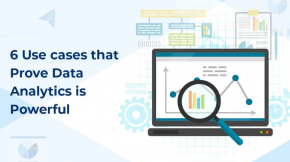Various Industrial applications of the Snowflake Data Cloud
Data is the lifeblood of any organization. Yet, most struggle with managing it. Gartner reports 91% of IT staff time is spent maintaining infrastructure rather than driving innovation. Why? Data silos. These prevent organizations from realizing value. 87% of decision makers want more external data. But legacy systems make this impossible.
Enter Snowflake. This leading cloud data platform transforms how organizations use data. It eliminates silos and unlocks quick data access for improved decision-making. With Snowflake, you can remove lag & latency from your current data architecture. Fast data processing, ironclad security, and exceptional performance and a decent expense. These are some holistic benefits of Snowflake.
Let’s explore some specific use cases of Snowflake. We’ll see how Snowflake’s modern data cloud has streamlined operations and has introduced process automation for various industry sectors like Manufacturing, Financial Services, Nonprofits, and Healthcare. Along the way, we’ll highlight its key features and benefits. So don’t miss out and read on.
Snowflake Use Cases across industries
Use Cases in Manufacturing:
Manufacturing depends on data. Production volumes. Machine performance. Inventory levels. But data trapped in silos stunts efficiency. Snowflake fixes this. It unites disparate data on one platform. Here lie the keys to optimizing supply chains, increasing uptime and ensuring quality. Let’s see how top manufacturers use Snowflake.
Supply Chain Optimization:
Visibility is everything in supply chains. Without it, gaps appear between production, inventory and logistics. Goods get stuck. Costs balloon out of control. With Snowflake, you gain total clarity.
For example, one automotive manufacturer uses Snowflake to manage its vast supplier network. The platform ingests 55,000 global supplier records. It then models inflation indexes to guide pricing. This reduces P&L volatility by 15%. By optimizing its supply chain data, the company cuts costs and prevents disruption.
Snowflake also provides real-time inventory insights. One industrial manufacturer uses these to identify production bottlenecks. Analysing Snowflake data revealed a shortage of castings holding up output. By addressing this promptly, they prevented stalling assembly lines. The result? A 10x increase in performance.
In total, Snowflake manages 3.5 million SKUs for this manufacturer. This massive scale enables data-driven decisions on pricing, logistics and resource allocation. It leads to supply chain excellence.
Predictive Maintenance:
Unexpected downtime crushes productivity. But with Snowflake, manufacturers can look into the future. The platform integrates data from sensors across the factory floor. Advanced analytics then forecast problems before they occur.
For example, one automotive plant uses Snowflake to anticipate paint defects. By analysing imagery and processing data, they identify potential coating issues. This allows proactive corrections to avoid scrapping entire batches. The plant increased uptime over 20% with predictive maintenance.
Snowflake also optimizes maintenance scheduling. By understanding failure risk for specific components, manufacturers can optimize staffing. Emergency repairs are avoided through planned interventions. This balanced approach reduces labour costs while keeping machines humming.
Product Quality Control:
Customers expect perfection, every time. With Snowflake, manufacturers can deliver. The platform provides real-time quality insights, powering rapid corrective actions.
For instance, one packaging equipment maker uses Snowflake for instant defect detection. They perform inline analytics during box folding and sealing. Any anomalies automatically trigger tweaks to get operations back on track. This nimble closed-loop process results in near-flawless quality.
Post-production, Snowflake assists quality assurance too. By reviewing measurements and test data across product batches, deviations get quickly identified. Addressing these early prevents wasteful recalls or returns. For one manufacturer, optimizing post-production QA with Snowflake reduced scrap costs by 5%.
By enabling real-time quality analysis, Snowflake leads to happier customers and leaner operations.
To recap, Snowflake unlocks immense value in manufacturing. It optimizes supply chains through visibility. Uptime increases with predictive maintenance. And quality improves through real-time analytics. Snowflake solves data problems at industrial scale. It’s why the world’s smartest manufacturers run on Snowflake.
Use Cases in Financial Services:
Financial services depend on data-driven decisions. But legacy systems obstruct this goal. They create disjointed datasets across business units. Snowflake fixes this by uniting siloed data on a single platform. Let’s explore key use cases in banking, insurance and beyond.
Fraud Detection and Prevention:
Fraud costs the finance industry over $40 billion annually. But with Snowflake, these losses decline dramatically. How? By enabling real-time analysis to pinpoint suspicious activities.
For instance, one bank uses Snowflake to instantly detect fraudulent transactions. They analyse spending patterns across billions of rows of customer data. Anomalies automatically trigger alerts to freeze affected accounts. This real-time monitoring halved the bank’s fraud losses.
Snowflake also helps insurers combat fraudulent claims. By running analytics across historical submissions, suspicious patterns appear. Things like inflated vehicle damages or inconsistent medical records. With these insights, insurers can better validate claims before issuing payments. This protects profits without compromising customer service.
Personalized Customer Experiences:
Customer expectations evolve quickly in financial services. Meeting them takes knowing individuals at a personal level. Snowflake makes this possible through unified customer data and robust analytics.
For example, one investment firm uses Snowflake to deliver tailored portfolio recommendations. By analysing customers’ full financial pictures, their advisors create optimized investment plans. These align to specific goals like retirement or education savings. The results are satisfied customers and improved returns.
In banking, Snowflake powers customized lending products. Analysing income, assets and credit history data informs loan offers at the individual level. This aligns financing to customers’ unique needs, improving satisfaction and long-term relationships.
Risk Management and Compliance:
Managing risk is central to financial services. But disjointed data makes this difficult, opening gaps in insights. Snowflake fixes this by consolidating data onto a single platform.
For instance, one investment bank uses Snowflake to improve counterparty risk analysis. By combining trading data with credit ratings and macroeconomic indicators, they enhance risk assessment for transactions. This informed approach reduces potential losses from defaults.
On the compliance side, Snowflake provides transparency needed to navigate complex regulations. It offers unified visibility into all customer, transaction and position data. This simplifies audits, reporting and adherence monitoring. One regional bank used Snowflake to cut compliance costs by 18% annually.
Snowflake’s cloud delivery model also minimizes business continuity risks. Unlike on-premise solutions, Snowflake offers built-in failover and redundancy to avoid downtime. For an industry that runs 24/7, this resilience is invaluable.
Use Cases for Non-Profits:
Non-profits strive for maximum mission impact with limited resources. Most struggle due to fragmented data and cumbersome technology. Snowflake simplifies their operations for greater efficiency. Let’s explore key use cases.
Donor Relationship Management:
Donors are the lifeblood of non-profits. Snowflake helps nurture these critical relationships by unifying data.
For instance, one environmental nonprofit uses Snowflake to engage its supporter base. The platform combines data on donations, email opens, event attendance and volunteer activity. This complete picture informs segmented outreach campaigns to drive higher response rates. Personalized donor communication has increased recurring contributions by 12%.
Program Effectiveness Evaluation:
Demonstrating impact secures funding for non-profits. But siloed data makes this hard. Snowflake solves this by centralizing program inputs and outcomes.
For example, a youth development non-profit uses Snowflake to quantify its impact. The platform ingests data on participation, demographics, family circumstances and academic performance. Powerful analytics then reveal links between program activities and outcomes. Quantifying impact this way has helped the non-profit expand funding by 22%.
Operational Efficiency:
Non-profits need to squeeze the most impact from every dollar. Snowflake delivers through optimized operations and resource allocation.
One global relief non-profit, for instance, uses Snowflake to coordinate disaster response. By tracking supplies, personnel and logistics in one place, they gain end-to-end visibility. This enables dynamically routing resources where needs are greatest. Response time to critical incidents has improved by 57%.
Snowflake also helps non-profits collaborate and share knowledge. It provides a common platform for dispersed teams to access data seamlessly. For example, a healthcare non-profit uses Snowflake to sync medical research results across seven countries. This fosters innovation and accelerates finding new treatments.












